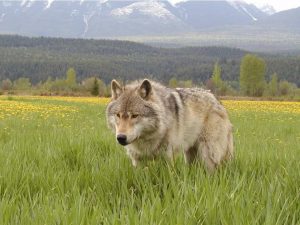
The USDA releases a death census for the cattle industry every 5 years and tracks how many cattle have died and from what causes. The results are less sensational than one might expect; dust and shipping stress kill three times more cattle than all predators combined.
So the last census for the entire U.S was in December of 2015— Cattle losses were due to non-predator causes was 98 percent. Respiratory problems accounted for the highest percentage of deaths in both cattle and calves. Pneumonia and shipping fever were given as examples of respiratory problems. Almost 24 percent of cattle deaths and almost 27 percent of calf deaths were due to respiratory issues. This amounts to an estimated 917,090 head of cattle and calves lost in 2015. We know that wolves prefer their native prey and were certainly not a large contributor to cattle and calf death losses even though most cattle producers claim wolves are the biggest problem.
While we realize that depredation by wolves can affect some of the cattle producers, it certainly could be avoided by deterrents and security. The biggest problem are the producers that put their livestock on public lands. With so many cattle roaming around on open land, they are like sitting ducks and too easy for the taking. Who wouldn’t want the opportunity of acquiring a very easy meal? While there are some that use range riders there is often far too much land to cover that is being used and all the cattle on the loose. In addition, the vast majority of riders are not out around the clock, especially at night when most depredations occur. The most responsible thing for the producers to do is not put cattle on our public lands. Plus the impacts on our wildlands, water, and riparian habitats is certainly not worth it. ~L.G
So in this article, Collaboration, compromise needed for wolves, producers —Laurie Groskop with USDA published March 2, quoted statistics from a National Agricultural Statistics Service and claimed: “In Wisconsin, cattle deaths by predator are heavily influenced by the presence of wolves.” Ms. Groskopt’s interpretation is a gross misrepresentation of the facts.
The NASS report is based on a random sample of surveyed U.S. producers. It is not based on livestock depredation events that were investigated and/or verified. For example, Alabama and Texas each show livestock deaths due to wolves even though no wolves exist in those states. The data for Wisconsin reflects 3.1 percent of calf deaths attributed to grizzly bears which is unlikely. Other states without populations of grizzly bears, mountain lions or wolves also show livestock losses by those species.
Wisconsin has 24,300 dairy and beef cattle farms with 1,544,000 head of cattle. While wolves typically hunt for wild animals, they will occasionally prey on livestock when the opportunity arises. Many incidents of predation are avoidable by removing attractants such as dead or dying livestock, and increasing security.
Even with nearly 1000 wolves on the Wisconsin landscape, the risk to livestock is extremely low, especially when compared to other losses such as weather and medical issues. In 2017, there were 30 cattle/calf deaths either verified or likely caused by wolves (additionally, four sheep were killed). But for producers, any loss, regardless of the cause, can be a financial and emotional burden which is why we support compensation for losses caused by wolves.
Although some argue that a wolf hunting season is needed to reduce conflicts, research suggests that hunting wolves to protect livestock is not effective in reducing conflicts. Targeted lethal removal, which will be allowed when wolves lose federal protection, should be used as a last resort in the infrequent instances when non-lethal measures fail and livestock depredations become chronic.
The key to a future for wolves is retaining public support by minimizing conflicts. But, that will take respect, listening and a willingness to collaborate and compromise. We need to work together to find ways for wolves and producers to coexist and make management decisions based on science, using factual data and not politics.
Nancy Warren, Executive Director, National Wolfwatcher Coalition
Comments
Pingback: Coexistence is key! | Protect The Wolves